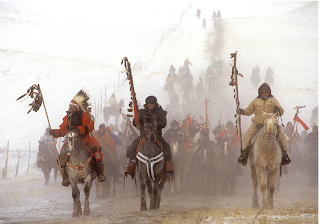Impact of Horse (1680-1875).
Horses revolutionized Native life and became an integral part of tribal cultures, honored in objects, stories, songs, and ceremonies.
Horses changed methods of hunting and warfare, modes of travel, lifestyles, and standards of wealth and prestige.
After a long absence- the horse returns.
Horse trading among Nations.
After a long absence- the horse returns.
The horse originated in the Americas more than 40 million years ago. After spreading to Asia and Europe, it became extinct in its homeland. In 1493, the horse returned to the Western Hemisphere when Columbus brought a herd of 25 on his second voyage. Back in the Americas, its native environment, the horse flourished.
The Spanish used the horse as an instrument of warfare and control. But as soon as horses came into Indian hands, Native peoples began to weave a close relationship with the Horse Nation. By the late 1700s, virtually every tribe in the West was mounted. Horses strengthened Native communities and helped in the fight for Indian lands.
A Terrifying first vision.
For many Native peoples, the first sight of a horse was terrifying. A Spanish soldier on horseback seemed to be a single monstrous creature. The Spanish used this terror to advance their conquest, sometimes attaching bells to their armor to add more noise and confusion.
In the islands of the Caribbean, Taíno people were the first to see the horse, and the sight inspired fear—animal fused to sword-wielding conquistador—the legs of the rider blending with the galloping extremities of his mount as it rode down Native people, while the metal of rein and bit and stirrup clanged with the fury of war.
—José Barreiro (Taíno), NMAI, 2009
Horses spread across the land.
The Spanish used horses as powerful weapons of conquest and made every effort to keep them out of Native hands.
But, gradually, Spanish horses became Indian horses. Strays from colonial ranches and settlements formed wild herds that Native people caught and tamed. Other horses were captured in raids and rebellions against colonial forces. As horses spread across the Americas, they transformed Native lifestyles and became an important ally in fighting the European invaders.
The Pueblo Revolt Opens the Gate.
In 1680, after a century of Spanish domination, the Pueblo Indians rose up against their colonial rulers in the region now known as New Mexico. Led by Popé, a Tewa religious leader, they attacked Santa Fe, killing some 400 Spaniards and forcing many more to flee. Hundreds of horses—perhaps more than 1,500—were left behind, the largest number to pass into Native hands at one time.
These horses became the ancestors of many tribal herds. The Pueblo people traded horses to neighboring tribes, and the horse population expanded rapidly across North America.
Spain’s monopoly of horses in the Americas was over.
In the West, horses dispersed quickly along Native American trading routes—first from the Pueblo to the Navajo, Ute, and Apache. The Comanche on the southern Plains traded them north to their kinsmen the Shoshone. These were among the first tribes to incorporate horses into their way of life.
By 1700 horses had reached tribes in the far northwest—the Bannock, Nez Perce, Cayuse, Umatilla, and others. Trading links sent them east to the River and Mountain Crow and Missouri River tribes.
The Pueblo, Navajo, Apache, Ute, Comanche, and Shoshone were some of the first Native peoples to acquire horses. The objects shown here represent the lasting bond between them and their mounts.
In the 1700s, as horses were moving north from Mexico, guns were moving west from New England, courtesy of English, Dutch, and French traders. On the Great Plains, the two lines of trade met. The result was the mounted Plains warrior, who would be a feared opponent of United States expansion into the West.












No comments:
Post a Comment